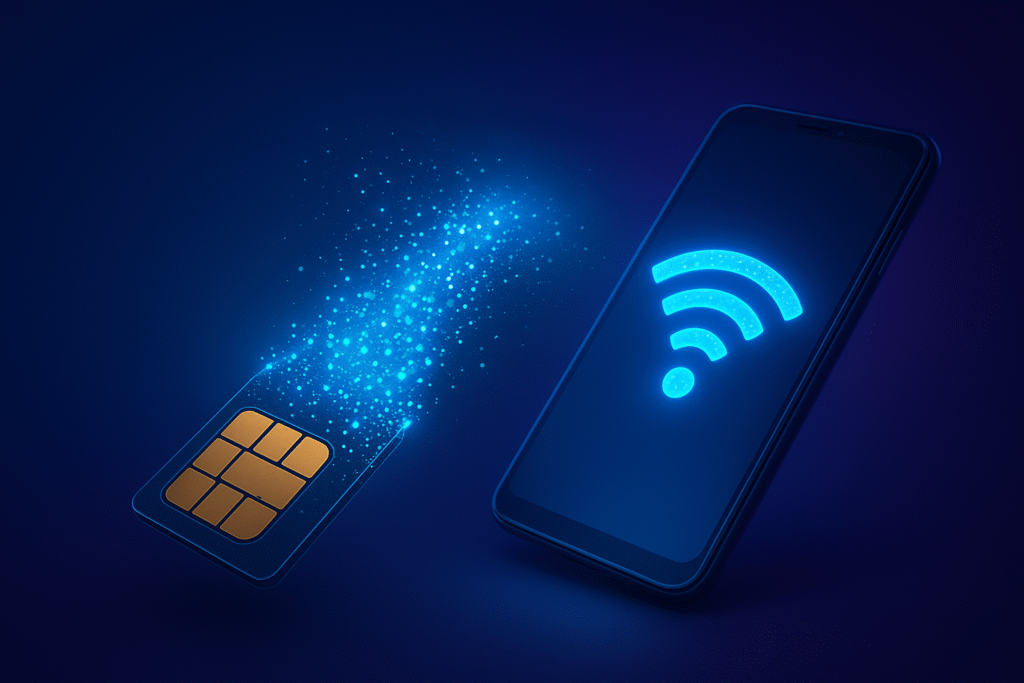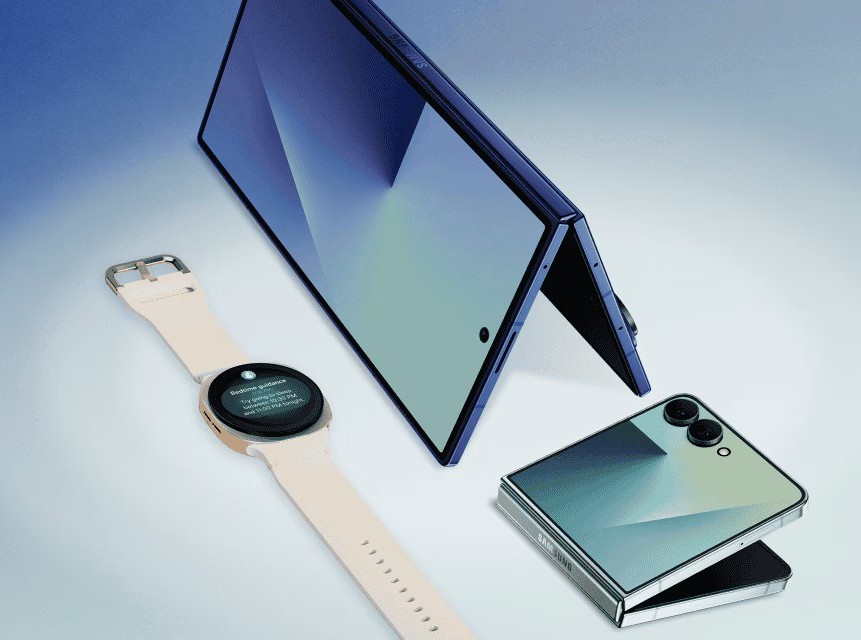
The tiny plastic card that defined mobile connectivity for decades is about to vanish and it’s taking our assumptions about how phones work with it.
Picture this: You’re rushing through an airport, desperately trying to swap SIM cards between your old phone and new one. Your fingernails are too short. The tiny metal tray keeps jamming. And somewhere in the chaos, that microscopic piece of plastic your digital lifeline goes flying across the terminal floor.
Sound familiar? Well, grab a tissue for your SIM card grief, because 2025 is writing its obituary.
The Invisible Revolution Inside Your Pocket
We’re witnessing something remarkable: the death of physical infrastructure in favor of digital elegance. The eSIM that “e” stands for “embedded” isn’t just a technological upgrade. It’s a fundamental reimagining of how we connect to the world.
Think of it as the difference between carrying a physical key and having a smart lock that responds to your presence. Same result, completely different experience.
What Exactly Is This Digital Wizardry?
An eSIM is essentially a SIM card that lives as software inside your device’s hardware. Instead of a removable chip, it’s a permanent component that can be programmed and reprogrammed remotely.
The magic happens through something called remote SIM provisioning a fancy term that means your phone can download and install carrier profiles over the internet, just like downloading an app.
The Human Translation: Your phone becomes a digital chameleon, capable of switching network identities without you ever opening the device.
The Domino Effect: When Tech Giants Go All-In
The industry’s biggest players aren’t tiptoeing into this transition they’re cannonballing:
Apple’s Bold Bet
The iPhone 17 series, including the ultra-thin iPhone 17 Air, is ditching the SIM tray entirely in most global markets. Apple’s reasoning? Every millimeter counts when you’re engineering the impossible phones that feel more like premium jewelry than technology.
Google’s Digital-First Philosophy
The Pixel 10 series has already gone full eSIM in the U.S. market, treating physical SIM cards like floppy disks technically functional, but fundamentally outdated.
Samsung’s Strategic Follow
Even Samsung, traditionally more conservative with radical changes, is preparing eSIM-only Galaxy S25 models for select markets. When Samsung follows Apple’s lead this quickly, you know the shift is inevitable.
The Meta-Pattern: We’re not just seeing product updates we’re witnessing coordinated industry evolution.
Why Your Next Phone Might Be Better Without That Little Slot
The benefits of eSIM-only design extend far beyond convenience:
Engineering Elegance
Without a SIM tray, phones become more like sealed ecosystems. Better waterproofing, fewer failure points, and that precious internal space can house larger batteries or improved cameras. It’s Marie Kondo for smartphone design removing what doesn’t spark engineering joy.
The Traveler’s Dream
Remember buying local SIM cards in foreign countries? Soon, that’ll be as antiquated as buying physical maps. With eSIM, switching to a local carrier becomes a 30-second digital transaction, often handled automatically through your phone’s settings.
Environmental Intelligence
Every year, billions of plastic SIM cards are manufactured, shipped, and eventually discarded. eSIM technology transforms this physical supply chain into efficient data transfers. Less plastic, fewer trucks, smaller carbon footprint.
The Flexibility Factor
Here’s where it gets interesting: eSIM allows for multiple carrier profiles simultaneously. Imagine having your work line, personal line, and travel data plan all managed through software, switching between them as seamlessly as changing playlists.
The Plot Twists: What Could Go Wrong?
No technological revolution comes without friction:
The Carrier Compatibility Challenge
Not every wireless carrier embraces eSIM technology equally. Smaller regional carriers often lag behind, potentially creating connectivity dead zones for eSIM-only devices.
The Human Impact: Your phone choice might suddenly dictate your carrier options, rather than the other way around.
The Digital Divide Reality
Physical SIM cards are democratic they work in any compatible device, regardless of software sophistication. eSIM requires modern devices with specific capabilities, potentially leaving behind users with older phones or limited technical knowledge.
The Troubleshooting Paradox
When your phone dies, swapping the SIM card to a backup device is straightforward. With eSIM, device failure could mean temporarily losing your digital identity while you navigate carrier support systems.
Beyond Phones: The Connected Everything Future
The eSIM story extends far beyond smartphones:
The Wearable Web
Your smartwatch, fitness tracker, and eventually your smart clothing will connect independently to cellular networks. Each device becomes its own communication node, creating a personal area network that follows you everywhere.
Laptop Liberation
Why tether your laptop to Wi-Fi hotspots when it could have its own cellular connection? eSIM-enabled laptops are already emerging, promising true mobile productivity.
The IoT Explosion
From smart cars to delivery drones, eSIM enables internet connectivity for devices that could never accommodate physical SIM slots. We’re moving toward a world where everything that benefits from being online, will be online.
The Strategic Takeaway: Adaptation Over Resistance
Here’s what this means for you:
If You’re Buying a New Phone: Research eSIM support with your current carrier before purchasing. The transition period might require some planning.
If You’re a Frequent Traveler: eSIM-capable devices will become your best friend. Start exploring international eSIM providers now.
If You Value Flexibility: The ability to manage multiple phone numbers and plans through software rather than hardware represents genuine convenience evolution.
If You’re Concerned About Change: Physical SIM cards won’t disappear overnight. Expect a 2-3 year transition period where both options coexist.
The Bigger Picture: Invisible Infrastructure Revolution
The eSIM transition represents something larger than mobile technology it’s part of humanity’s ongoing migration from physical to digital infrastructure. Just as we moved from physical maps to GPS, from CDs to streaming, from cash to digital payments, we’re now moving from physical identity cards to digital authentication.
This shift mirrors broader technological evolution: the best technology disappears into seamless experience.
Your phone shouldn’t make you think about SIM cards any more than your car should make you think about fuel injection timing. The goal is invisible, effortless functionality that just works.
What Happens Next?
The eSIM revolution isn’t just about phones it’s about reimagining connectivity itself. As this technology matures, expect:
- Instant Activation: New phone setups that complete in minutes, not hours
- Dynamic Pricing: Carrier plans that adjust automatically based on usage and location
- Seamless Roaming: International travel without connectivity anxiety
- Device Simplicity: Phones with fewer ports, buttons, and potential failure points
The future doesn’t just connect your devices to networks it makes that connection so elegant, you forget it exists.
The Question Isn’t Whether This Change Is Coming It’s Whether You’ll Lead or Follow.
What’s your take on the eSIM transition? Ready to bid farewell to that tiny plastic lifeline, or holding onto physical SIM cards until they pry them from your cold, dead phone? Share your thoughts the revolution wants to know where you stand.
Disclaimer: This blog post was generated with the help of artificial intelligence. Readers are encouraged to verify facts independently.


